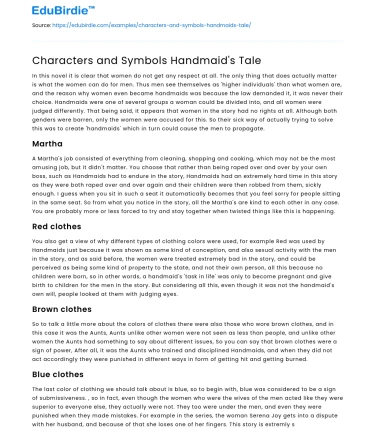Introduction
Margaret Atwood's The Handmaid's Tale is a seminal work that delves into themes of power, control, and resistance within a dystopian society. The novel is set in the Republic of Gilead, a totalitarian regime where women's rights are severely restricted, and their roles are strictly defined. Atwood uses a rich tapestry of characters and symbols to explore the complexities of identity, freedom, and oppression. Through these literary devices, the narrative not only critiques the socio-political issues of the time but also resonates with contemporary debates on gender and authority. Key characters such as Offred, Serena Joy, and the Commander are not only central to the plot but also serve as embodiments of various societal forces. Meanwhile, symbols like the red garments and the Eye contribute to a deeper understanding of the pervasive control mechanisms within Gilead. This essay will examine how Atwood employs character development and symbolism to underscore the novel's thematic concerns.
Characterization in The Handmaid's Tale
In Atwood's narrative, characters are meticulously crafted to reflect the intricate dynamics of power and submission in Gilead. The protagonist, Offred, personifies the struggle for autonomy in a society that seeks to erase individuality. Through her eyes, readers experience the dehumanizing effects of the regime. Offred’s internal monologues and memories serve as a poignant contrast to her external compliance, revealing her resilience and desire for freedom. As noted by critic Coral Ann Howells, Offred’s narrative is "a testimony of survival" (Howells, 1996). Her nuanced portrayal underscores the human capacity to adapt and resist even in the direst circumstances.
Conversely, Serena Joy, the Commander’s wife, represents the paradox of complicity and victimhood in Gilead. Once a prominent advocate for traditional values, Serena finds herself trapped in the very system she helped create. Her interactions with Offred are fraught with tension, as she oscillates between enforcing the regime's rules and expressing her own bitterness and dissatisfaction. This complexity adds depth to her character, illustrating how oppressive systems can ensnare even those who seemingly benefit from them. The Commander, on the other hand, is a study in the corrupting influence of power. His clandestine meetings with Offred reveal his hypocrisy and the moral decay that underpins his authority. Through these characters, Atwood critiques the structures of power that sustain such a dystopian world.
Symbolism and Its Significance
Atwood employs an array of symbols to enrich the narrative and provide insight into the psychological and social ramifications of Gilead's regime. One of the most prominent symbols is the red garment worn by the Handmaids. The color red signifies fertility, serving as a constant reminder of their biological function within the society. However, it also symbolizes the blood and violence underlying the regime’s control. As literary critic Sharon Wilson points out, "the red habit becomes a symbol of their humiliation and subjugation" (Wilson, 2006). This dual symbolism captures the complexity of the Handmaids' plight, as they are both revered and oppressed for their reproductive capabilities.
The Eye, another recurring symbol, represents the omnipresent surveillance and control exercised by the state. It instills a sense of paranoia and fear among the citizens, reinforcing the regime's power. This symbol is particularly relevant in modern discussions on privacy and surveillance, highlighting the timeless nature of Atwood's critique. Furthermore, the Wall, where bodies of executed dissidents are displayed, serves as a stark reminder of the consequences of defiance. It is both a physical and psychological barrier that reinforces the regime’s grip on power. Through these symbols, Atwood effectively conveys the oppressive atmosphere of Gilead and the pervasive reach of its control mechanisms.
Counter-arguments and Critiques
While Atwood's use of characters and symbols has been widely praised, some critics argue that her portrayal of Gilead lacks nuance and oversimplifies complex socio-political issues. For instance, some scholars contend that the novel's focus on gender dynamics overshadows other intersecting factors such as race and class. In her critique, Angela Laflen suggests that "the novel’s dystopian vision could benefit from a more intersectional approach" (Laflen, 2018). This perspective invites readers to consider how an even broader range of identities and power structures could be explored within the narrative framework.
Moreover, some readers feel that the novel's symbolism can be heavy-handed at times, potentially detracting from the subtlety of its message. However, it can be argued that the starkness of Atwood's symbols serves to underscore the extremity of Gilead's regime, effectively driving home the urgency of its themes. Despite these critiques, The Handmaid's Tale remains a powerful exploration of the dangers of unchecked power and the resilience of the human spirit.
Conclusion
In conclusion, Margaret Atwood's The Handmaid's Tale employs a rich interplay of characters and symbols to explore the themes of power, control, and resistance. Through the development of characters like Offred, Serena Joy, and the Commander, Atwood delves into the complexities of identity and autonomy within a repressive society. The symbolic elements, such as the red garments and the Eye, further enhance the narrative by illustrating the pervasive mechanisms of control in Gilead. Despite some criticisms, the novel's enduring relevance and impact underscore its significance as a cautionary tale about the potential consequences of authoritarianism. By examining these literary elements, readers are invited to reflect on the broader implications of Atwood's work in the context of contemporary social and political issues.






 Stuck on your essay?
Stuck on your essay?

